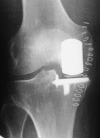A second decade lifetable survival analysis of the Oxford unicompartmental knee arthroplasty
- PMID: 20706811
- PMCID: PMC3008876
- DOI: 10.1007/s11999-010-1506-2
A second decade lifetable survival analysis of the Oxford unicompartmental knee arthroplasty
Abstract
Background: The role of unicompartmental arthroplasty in managing osteoarthritis of the knee remains controversial. The Oxford medial unicompartmental arthroplasty employs a fully congruent mobile bearing intended to reduce wear and increase the lifespan of the implant. Long-term second decade results are required to establish if the design aim can be met.
Questions/purposes: We report the (1) 20-year survivorship for the Oxford mobile bearing medial unicompartmental knee arthroplasty; (2) reasons for the revisions; and (3) time to revision.
Methods: We reviewed a series of 543 patients who underwent 682 medial Oxford meniscal bearing unicompartmental knee arthroplasties performed between 1983 and January 2005. The mean age at implantation was 69.7 years (range, 48-94 years). The median followup was 5.9 years (range, 0.5 to 22 years). One hundred and forty-one patients (172 knees) died. None were lost to followup. The primary outcome was 20-year survival, a key variable in assessing the longevity of arthroplasty.
Results: The 16-year all cause revision cumulative survival rate was 91.0% (CI 6.4, 71 at risk) and survival was maintained to 20 years (91.0%, CI 36.2, 14 at risk). There had been 29 revision procedures: 10 for lateral arthrosis, nine for component loosening, five for infection, two bearing dislocations, and three for unexplained pain. In addition, five patients had undergone bearing exchange, four for dislocation and one for bearing fracture. The mean time to revision was 3.3 years (range, 0.3-8.9 years).
Conclusions: Mobile bearing unicompartmental knee arthroplasty is durable during the second decade after implantation.
Level of evidence: Level IV, therapeutic study. See the Guidelines for Authors for a complete description of levels of evidence.
Figures
Similar articles
-
Does bearing design influence midterm survivorship of unicompartmental arthroplasty?Clin Orthop Relat Res. 2010 Jan;468(1):73-81. doi: 10.1007/s11999-009-0975-7. Epub 2009 Jul 14. Clin Orthop Relat Res. 2010. PMID: 19597898 Free PMC article.
-
Bearing Dislocation and Progression of Osteoarthritis After Mobile-bearing Unicompartmental Knee Arthroplasty Vary Between Asian and Western Patients: A Meta-analysis.Clin Orthop Relat Res. 2018 May;476(5):946-960. doi: 10.1007/s11999.0000000000000205. Clin Orthop Relat Res. 2018. PMID: 29406457 Free PMC article.
-
Medial Mobile-Bearing Unicompartmental Knee Arthroplasty in Young Patients Aged Less Than or Equal to 50 Years.J Arthroplasty. 2018 Aug;33(8):2435-2439. doi: 10.1016/j.arth.2018.03.069. Epub 2018 Apr 9. J Arthroplasty. 2018. PMID: 29705680
-
Ten- to 15-year results of the Oxford Phase III mobile unicompartmental knee arthroplasty: a prospective study from a non-designer group.Bone Joint J. 2016 Oct;98 B(10 Supple B):41-47. doi: 10.1302/0301-620X.98B10.BJJ-2016-0474.R1. Bone Joint J. 2016. PMID: 27694515 Free PMC article.
-
Systematic review and meta-analysis of bearing dislocation in lateral meniscal bearing unicompartmental knee replacement: Domed versus flat tibial surface.Knee. 2021 Jan;28:214-228. doi: 10.1016/j.knee.2020.10.013. Epub 2021 Jan 7. Knee. 2021. PMID: 33422937
Cited by
-
Radiological outcomes following manual and robotic-assisted unicompartmental knee arthroplasty.Bone Jt Open. 2021 Mar;2(3):191-197. doi: 10.1302/2633-1462.23.BJO-2020-0205.R1. Bone Jt Open. 2021. PMID: 33739128 Free PMC article.
-
The cost-effectiveness of surgical treatment of medial unicompartmental knee osteoarthritis in younger patients: a computer model-based evaluation.J Bone Joint Surg Am. 2015 May 20;97(10):807-17. doi: 10.2106/JBJS.N.00925. J Bone Joint Surg Am. 2015. PMID: 25995491 Free PMC article.
-
Outcome of unicompartmental knee arthroplasty in octogenarians with tricompartmental osteoarthritis: A longer followup of previously published report.Indian J Orthop. 2013 Sep;47(5):459-68. doi: 10.4103/0019-5413.118201. Indian J Orthop. 2013. PMID: 24133305 Free PMC article.
-
Finite Element Study on the Preservation of Normal Knee Kinematics with Respect to the Prosthetic Design in Patient-Specific Medial Unicompartmental Knee Arthroplasty.Biomed Res Int. 2020 Mar 18;2020:1829385. doi: 10.1155/2020/1829385. eCollection 2020. Biomed Res Int. 2020. PMID: 32258105 Free PMC article.
-
Cemented versus Uncemented Oxford Unicompartmental Knee Arthroplasty: Is There a Difference?Adv Orthop. 2013;2013:245915. doi: 10.1155/2013/245915. Epub 2013 Dec 9. Adv Orthop. 2013. PMID: 24383006 Free PMC article.
References
-
- Insall J, Aglietti P. A five to seven-year follow-up of unicondylar arthroplasty. J Bone Joint Surg Am. 1980;62:1329–1337. - PubMed
-
- Laskin R. Unicompartmental tibiofemoral resurfacing arthroplasty. J Bone Joint Surg Am. 1978;60:182–185. - PubMed
-
- Marmor L. Unicompartmental arthroplasty of the knee with a minimum ten-year follow-up period. Clin Orthop Relat Res. 1988;228:171–177. - PubMed
Publication types
MeSH terms
LinkOut - more resources
Full Text Sources
Medical
Research Materials
Miscellaneous


